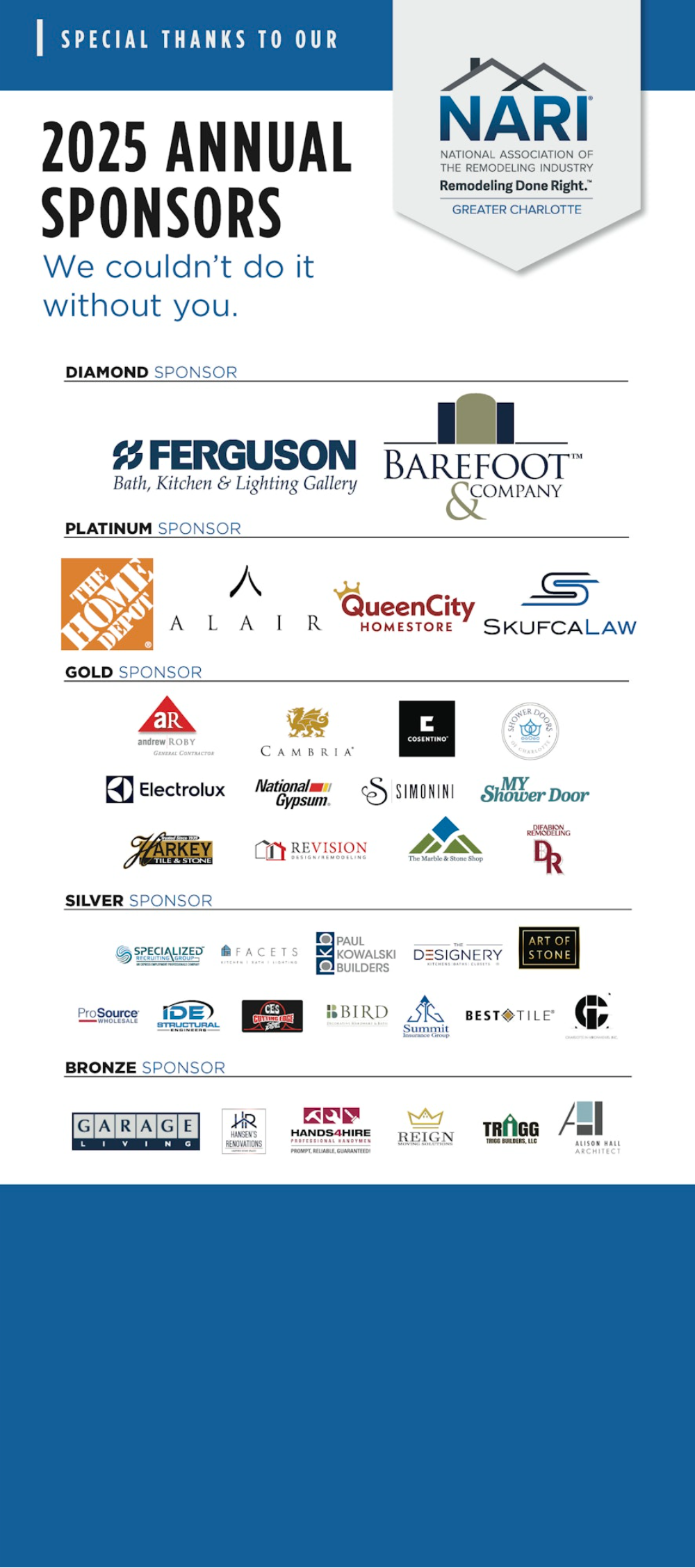-
Remodeling Checklist
-

When remodeling your home, planning ahead and taking it one step at a time is key. Home improvements, if done properly, can be painless and even fun. Remodeling is a decision that requires patience and planning. NARI Charlotte suggests the following 10 Step Program When Remodeling:
Step One:
Assess your current situation. Make sure you have the financial resources, time, and patience to undertake a remodeling project before you start.
Step Two:
Decide how long you intend to live in your present home. If you plan on selling your home in the next few years, check the real estate comparisons for your neighborhood to see how much you can invest in remodeling and still recoup those costs when you sell the home.
Step Three:
Define the areas of the home you want to change. Have some idea of what you want the remodeling project to include and what rooms you would like to change before calling a contractor. Make a list of the rooms you would like to remodel as well as the reasons for the changes. You may want to look through consumer magazines for ideas. Depending on your need and the size and complexity of your intended remodeling project, there are several different options for you to explore to begin your remodeling.
The Architect—Major remodeling projects require construction drawings for the purposes of defining a contract and procurement of permits. In cases where your professional remodeler does not provide design services, you may wish to seek the assistance of a professionally trained architect. It is best to work with an architect experienced in remodeling–he or she will be more sensitive to the special challenges that remodeling represents.
The General Contractor—Many home improvement projects may not require professional design services and can best be handled by the experienced contractor whose knowledge of materials and methods has been gained by years on the job. Even small jobs need careful planning and attention to details.
The Design/Build Contractor—Design/build is a concept developed to benefit the homeowner by providing both quality design and construction services within the same general contracting company. A design/build contractor will be able to see your project through from start to finish, keeping design, engineering and budget in mind.
Step Four:
Allow plenty of time for the remodel. Keep in mind that delays may occur during the project due to materials shortages, weather and unforeseen problems. Delays are especially common for special orders and kitchen cabinets. Take these into account when creating a timetable with your contractor. An unrealistic time frame will only add to the difficulty and stress.
Step Five:
Hire a reputable contractor. The best way to protect yourself is to hire a professional. Horror stories abound from homeowners who have hired disreputable contractors. When choosing a contractor, make sure they are fully insured, meet all state licensing requirements, financially solvent and check references. A professional trade association, such as NARI Charlotte, can help direct you to reputable contractors that meet these criteria.
Most cities, towns and counties have established building codes. They vary from one jurisdiction to the next. A building permit generally is required whenever structural work is involved or when the basic living area of a home is to be changed. If you have a home with an unfinished basement and would like to finish off a portion of it for a family room, you would need a building permit because you have changed storage space to livable space.
Do not obtain your own building permit. In most jurisdictions, the person obtaining the permit is considered to be the contractor and is, therefore, liable if the work does not comply with local building codes. The complex elements of local building codes and permits are familiar details to a professional remodeling contractor.
Step Six:
Create a realistic budget. Decide how much money you can spend on home improvements before undertaking the project. Obtaining more than one quote from reputable contractors can help ensure your vision is feasible within your budget.
Step Seven:
Get a comprehensive proposal from your contractor. This allows you to know upfront how much money the project will cost. The proposal should also include the specific types of products that will be used. Be sure to ask about “allowances” (items that can vary in cost depending on what the homeowner chooses, such as fixtures, tile, cabinets, flooring, etc.) and how they are accounted for in the proposal. If the proposal is based on materials that cost less than what you end up selecting, you can run into cost overages very quickly.
Step Eight:
Get a signed contract before any work begins. The contract should detail the scope of the project, start and approximate completion dates, a payment schedule, product types, and responsibilities of the contractor and any subcontractors. The contract should also include provisions for change order procedures, warranties, and alternative dispute resolution clauses.
Specify all materials. Your contractor should detail a list of all materials for the project in your contract. This includes size, color, model, brand name and product.
Study all required plans carefully. Insist that you approve them and that they are identified in your written contract before work begins.
Federal law requires a contractor to give you written notice of your right to, without penalty, cancel a contract within three business days of signing it, provided it was solicited at some place other than the contractor’s place of business or appropriate premises–your home, for instance.
Understand the financial terms. Make sure that the terms are spelled out in the contract. The total price, payment schedule and cancellation penalty should be clear.
A warranty covering materials and workmanship for a minimum of one year should be written into the contract. The warranty must be identified as either “full” or “limited.” If it is a “full warranty,” all faulty products must be repaired or replaced, or your money returned. A “limited warranty” indicates all replacements and refunds of damaged products are limited in some regard. The name and address of the party who will honor the warranty (contractor, distributor, or manufacturer) must be identified. Make sure the time period for which the warranty is offered is clearly specified.
A binding arbitration clause is also a good inclusion in the event a disagreement occurs. Arbitration can enable you to resolve disputes more quickly and effectively without costly litigation.
Thoroughly review the entire contract and be certain you fully understand it before signing it. Consider the scope of the project and make sure all items you’ve requested are included. Never sign an incomplete contract and always be sure to keep a copy of the final document for your records.
Be sure to put all changes in writing if the scope or complexity of your remodeling project is modified while work is being done. The amendment should be agreed upon and signed by both parties.
Keep a job file including the contract, plans, specifications, invoices, change orders and all correspondence with the contractor.
Request a contractor’s Affidavit of Final Release be provided you at the time you make final payment. This is your assurance that you will not be liable for any third-party claims for nonpayment of materials or subcontractors.
Step Nine:
Tie payments to work stages. Avoid contractors who ask for the total cost or a large sum of money up front. Contractors will usually split payments into percentages of the total cost of the project. These payments are typically tied to significant stages of the project, and payments are rendered as parts of the job are completed. Kitchen remodels, however, often require a large amount of money at the beginning to cover the costs of ordering cabinets and appliances.
Step Ten:
Keep your perspective. Remodeling is disruptive to your normal household environment. It is important to take a deep breath, keep your focus, and work toward the end result. If problems occur, talk to your contractor about your concerns. Remember, remodeling is fun and before you know it, you’ll have the dream home you’ve always wanted.









